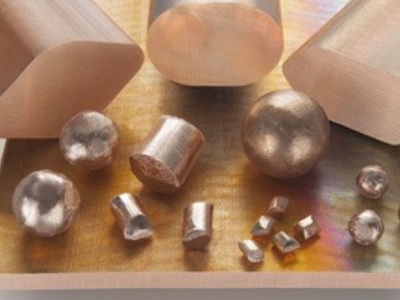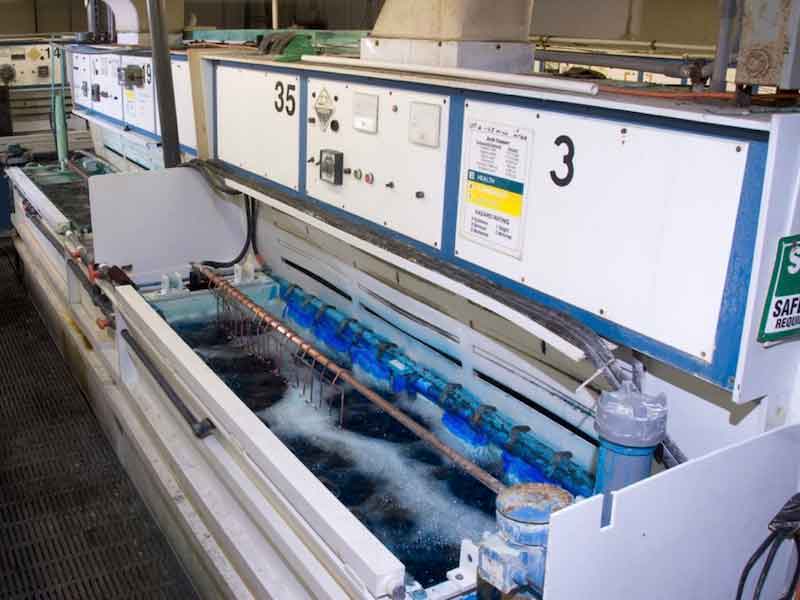Recently, the price of nickel skyrocketed to approximately $50/LB, prompting the LME to shut down nickel trading.
 Stephen F. Rudy CEFAfter a short time out, trading resumed. The recent price trend has seen it sort of level off in the $15-$18/lb range. By comparison, the “good old days” pricing of below $6/lb seems so long ago; realistically, I don’t expect these numbers to return. Thus, nickel electroplating and electroless nickel have become expensive and challenging for customers and finishers. Attention to detail, with respect to plating current densities, plating times, thicknesses, bath maintenance, and optimizing chemistry, all combine to leave critical room for deviation.
Stephen F. Rudy CEFAfter a short time out, trading resumed. The recent price trend has seen it sort of level off in the $15-$18/lb range. By comparison, the “good old days” pricing of below $6/lb seems so long ago; realistically, I don’t expect these numbers to return. Thus, nickel electroplating and electroless nickel have become expensive and challenging for customers and finishers. Attention to detail, with respect to plating current densities, plating times, thicknesses, bath maintenance, and optimizing chemistry, all combine to leave critical room for deviation.
Failure to meet any specific plating objective or operating parameters significantly adds to the overall plating cost. There is very little margin for error. The consequence is to erode what profit margin exists. Strip and replate typically erase the profit margin, perhaps tripling the cost compared to processing the job properly in the first place. Perhaps it would be beneficial to plate less nickel and yet meet the overall plating requirements and service characteristics for processed parts.
One way to accomplish this is to plate a rapidly leveling, bright nickel deposit. Known systems referred to as the “hot” or “pyridine” based proprietary brighteners readily deposit mirror-bright & highly reflective nickel. The overall benefit is to significantly reduce nickel deposit thickness while providing the required aesthetic characteristics. Corrosion protection or wear resistance, if important, may be compromised. If this is important, improved base metal protection can be achieved by plating a sufficient undercoating of copper. For many plating requirements, such as automotive finishes, this is very critical to obtaining the required wear resistance and meeting test parameters (CASS, salt spray, etc.).
In today’s pricing structure of metals, the consideration of copper (around $5.00-5.50/lb) as a suitable primary deposit can reasonably supplant nickel (around $18-20/lb) plating thicknesses. Although copper metal prices have also risen, these average about one-fourth that of nickel metal. This certainly makes the extended use of or introduction of copper plating more attractive, specifically in an economic sense. Acid copper plating develops a deposit with the following beneficial characteristics: very bright, highly leveling, ductile, and soft, readily buffed. Aside from ferrous and zinc metals, which require cyanide or alkaline copper deposit before acid copper, the acid copper can be plated directly onto brass and copper substrates. The application of acid copper may ease the “pain” of the nickel plating cost.
Let us consider an example of what a saving in nickel deposition can relate to when a portion of it can be replaced with copper. Consider nickel metal at $17/lb and copper metal at $5/lb. For every 100 lb of nickel metal-plated, the cost of depleted anode would be $1,700. It is replacing 25% of the nickel-plated with copper results in saving $425 of nickel while depositing in its place $125 of copper. Overall, the cost savings in total metal deposited versus just all nickel is $300 or 17.7%. There are other factors that can be compared, such as consumption of brighteners & additives and power requirements. On average, approximately one gallon of nickel brightener may be consumed for every 8,000 amp-hours. Conversely, one gallon of acid copper brightener may be consumed for every 25,000 amp-hours.
Based on data at 100% cathode efficiency, the deposition rate for nickel is 0.039 ounces per amp hour, and for copper, it is 0.042 ounces per amp hour.
From this perspective, let us review the basics of acid copper plating. The bright acid copper plating process is relatively simple to make up and maintain. Sulfuric acid is an important component constituent. This makes the bath a corrosive solution. All the safety precautions, handling, and use of proper equipment must be adhered to. SDS for process and related products and additives list all this information. The following information provides the basic concentrations and general operating parameters.
Bath Chemistry
CONSTITUENT OPTIMUM RANGE
*Copper Sulfate 28 oz/gal (210 gram/liter) 27-30 oz/gal (202.5-225 gram/liter)
Sulfuric Acid 8 oz/gal (60 gram/liter) 7-9 oz/gal (52.5-67.5 gram/liter)
Sulfuric Acid 3.2 % by volume 3.2-4.2 % by volume
Chloride Ion 70 ppm (70 mg/liter) 30-150 ppm (30-150 mg/liter)
Copper Sulfate Pentahydrate (liquid concentrate or crystals)
Operating Parameters
REQUIREMENT RANGES
Temperature 75-90°F (24-32°C)
Cathode CD 10-90 amps/ft2 (1.0-9.0 amps/dm2)
Anode CD 5-20 amps/ft2 (0.5-2.0 amps/dm2)
Voltage 2-9 volts
Anode to cathode ratio 2:1
Agitation Low pressure air blower (oil free)
Filtration Continuous, 1-2 turnovers/hour
 Temperature control is very important. Too low may result in some Copper Sulfate precipitation (clogged filters, deposit pitting, and anode polarization). Too high will consume more of the organic additives and by itself can dull the deposit.
Temperature control is very important. Too low may result in some Copper Sulfate precipitation (clogged filters, deposit pitting, and anode polarization). Too high will consume more of the organic additives and by itself can dull the deposit.
Agitation is also very important to prevent burning and rough deposits. It also permits the use of higher current densities and contributes to fine-grained, bright deposits.
Note: The information provided relates to the bright acid copper rack plating of most consumer and automotive goods. The other types of related processes for printing applications: rotogravure and textile, along with electroforming, are not referenced in this review.
The copper anodes required should contain 0.025% to 0.06% phosphorus. Do not use oxygen-free anodes in acid copper, as these are for cyanide-based copper baths. Anode baskets are titanium. Napped polypropylene or Dynel anode bags are recommended.
About the Bath Constituents
Copper Sulfate is the secondary source of metal in the plating bath. As in most plating baths, they are maintaining the Copper Sulfate above the minimum concentration required to prevent high current density burning and, lower plating rates, poor deposit leveling. Higher concentrations result in harmful precipitation of Copper Sulfate on the tank equipment, especially coating the anode baskets and deposit roughness. Managing proper anode area is therefore important. In long periods of non-use, the sulfuric acid component continually etches the anodes, resulting in copper metal buildup.
Sulfuric acid provides the solution conductivity, thereby lowering voltage for any current density. Higher concentrations of Sulfuric Acid promote high current density burning and passive anodes.
Chloride, in conjunction with the organic brightener/leveling additives, serves to prevent: deposit burning, dullness, poor leveling, and restricted plating current density ranges.
The organic additives consist of proprietary blends that control deposit: grain refinement, brightness, leveling, anti-burn, and prevent low current density skip plating.
Analytical Control
 Wet analysis procedures are commonly used. The copper sulfate is titrated per the iodine - thiosulfate couple method. Sulfuric acid is determined by acid neutralization titration with sodium hydroxide. Chloride is usually analyzed by a few different methods. In one, the sample is made cloudy by the addition of silver nitrate, and the % transmittance of light is measured. The logarithmic value is then determined, and concentration is extrapolated on a Beer’s Law graph. In another method, the sample is made cloudy by the silver nitrate addition, then titrated to clarity with mercuric nitrate. Care must be taken for handling and disposing of mercury-containing solutions.
Wet analysis procedures are commonly used. The copper sulfate is titrated per the iodine - thiosulfate couple method. Sulfuric acid is determined by acid neutralization titration with sodium hydroxide. Chloride is usually analyzed by a few different methods. In one, the sample is made cloudy by the addition of silver nitrate, and the % transmittance of light is measured. The logarithmic value is then determined, and concentration is extrapolated on a Beer’s Law graph. In another method, the sample is made cloudy by the silver nitrate addition, then titrated to clarity with mercuric nitrate. Care must be taken for handling and disposing of mercury-containing solutions.
A hull cell test normally provides an excellent determination of the deposit characteristics, especially highlighting any defects due to a bath out of balance condition.
Based on specific finishing applications, the possibility of replacing some of the nickel deposits may be an appropriate method for overall cost savings. Back in the 1970s, the emergence of nickel-iron alloy baths was somewhat popular during a period of higher nickel prices. This was a driving force in cost savings product development. Going back a bit farther to the good old days of 1969, the average price of nickel was $1.14/lb. It just goes to show that problems and opportunities do go hand in hand.
Stephen F. Rudy, CEF, is president of Chem Analytic and has written extensively about the finishing industry. Visit www.chemanalytic.com or call him at 917-604-5001.



































